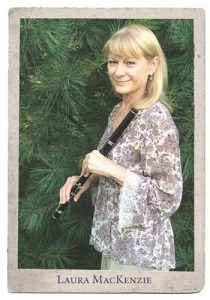
The Wanamingo Bulldogs and the Faribault Hot Shots have just completed a basketball scrimmage at the Faribault Community Center one cold Monday night in January. The Hot Shots have won, 35-22. The teams line up and slap each other’s hands.
“Good game!” they tell each other. They are all smiling. They are all “off their rockers.”
These two teams are the only Minnesota teams playing in the league for women age 50 and over known as Granny Basketball. They are in the East division with teams from Iowa – the Cedar Rapids Sizzlers and Late Bloomers, Center Point Model Ts, Dubuque Cuties, Harpers Ferry Fireflies and N.E. Iowa Great Dames. The western division includes other Iowa teams from Indianola, Ankeny, Gowrie and Monroe and three teams from Des Moines. There are three Southern division teams in Jefferson City, Mo., two in Texas, and one in Kansas, Louisiana and Virginia.
It’s no surprise that Iowa is the hotbed of Granny Basketball. Iowa has a long and storied girls’ basketball tradition which could only be envied for many years by girls in the neighboring state of Minnesota (see accompanying story). Granny Basketball started in 2005 when Barb McPherson, a retired nurse, was looking for a way to exercise and hit upon a revival of a form of girls’ basketball played in the 1920s. She and a group of friends in Lansing, Iowa, put together a tournament to raise money to preserve a historic building. Media coverage increased and teams kept playing, often games for charity against any teams that would play by their rules.
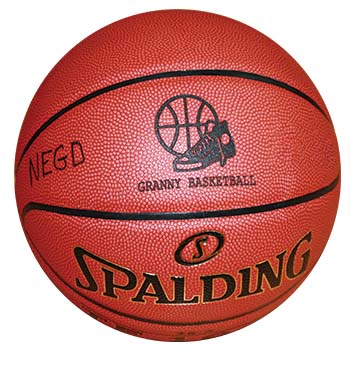 What is Granny Basketball? While it resembles the old six-on-six, two-court game girls played in my youth, Granny Basketball divides the floor into three parts, with a middle court found in early girls’ basketball which was mostly dropped by 1935. The two forwards (the only ones who can shoot baskets), two guards and two centers must stay within their boundaries, with only two dribbles and no running or jumping allowed except for a quick walk called “hurrying.” And no physical contact or “hovering” over the opponent. There are four eight-minute quarters of continuous play, except for falls and fouls, with one timeout per quarter. Underhand shots into the basket are worth three points because they are harder (more easily blocked), with two points for other field goals and one point for free throws.
What is Granny Basketball? While it resembles the old six-on-six, two-court game girls played in my youth, Granny Basketball divides the floor into three parts, with a middle court found in early girls’ basketball which was mostly dropped by 1935. The two forwards (the only ones who can shoot baskets), two guards and two centers must stay within their boundaries, with only two dribbles and no running or jumping allowed except for a quick walk called “hurrying.” And no physical contact or “hovering” over the opponent. There are four eight-minute quarters of continuous play, except for falls and fouls, with one timeout per quarter. Underhand shots into the basket are worth three points because they are harder (more easily blocked), with two points for other field goals and one point for free throws.
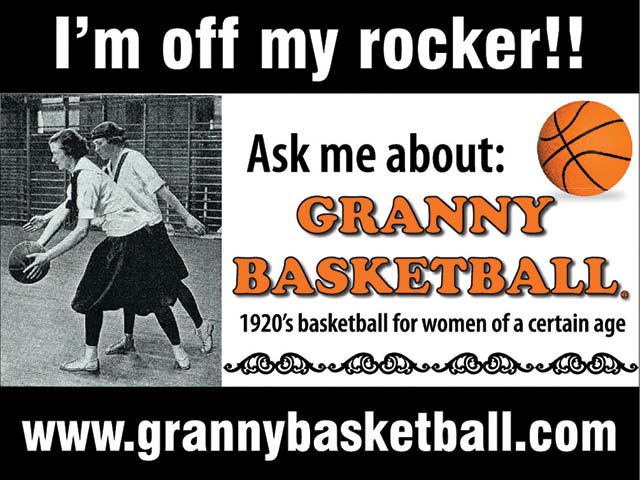
Then there are the throwback uniforms, middy white blouses with numbered collars, black bloomers and stockings which cover the legs. In fact, if legs or upper arms are bared, a “flesh foul” can be called. Tennis shoes complete the outfit. Founder McPherson has said their slogan is “Die with your tennies on,” which she explained as being similar to cowboys dying with boots on. She said: “We don’t want to die in a rocking chair or wheelchair – we’re going to die in action! It’s such a great stress reliever, too. Everyone has problems, but you get on the court, you don’t think about any of that. You just think about making the points, you leave your everyday life behind.” In a phone conversation, McPherson told me playing a team sport makes for a very social time and families have thanked her for providing this activity for this age group.
After the January scrimmage, I spoke with some of the players about Granny Basketball. Lois Bjorngaard and Karen Brant are co-captains of the Wanamingo Bulldogs, the first team established in Minnesota in 2007 after they heard about the league on a television news show and got more information online. Bjorngaard, who taught physical education in Wanamingo and Kenyon-Wanamingo schools, said at first the ladies practiced against husbands, grandchildren, “whoever we could sucker into coming and slowly we got more people.” The number of Grannies has grown to 14, the same number as on the Faribault team. Home games are played at the Kenyon-Wanamingo Elementary School gymnasium in Wanamingo. Brant told me, “I’m a Bulldog through and through. I grew up in Wanamingo, went to high school but never got to play – they didn’t have girls’ sports.” Sounding a familiar refrain, she exclaimed, “And I just love the game!”
Darlene Scott of the Hot Shots said she has arranged her family schedule around this activity since there was no opportunity for her to play in high school in Columbia Heights, either. She remembers being excited to hear her school was “going to start a tennis team” and being “bummed out” to find it was just for boys.
“It’s fun!” was the most common description given of their game by the Grannies. Karen Torjesen, now living on an organic farm between Kenyon and Wanamingo, grew up on a farm near Peterson, Minn., and, like others at the scrimmage, did not have the chance to play team sports. Now, at 78, this Professor Emerita of Pediatrics at Case Western Reserve University of Cleveland is in her seventh year playing for the Wanamingo team.

Mary Frazier of the Hot Shots loves to play the game which she was able to play at the University of Wisconsin-Eau Claire, but experience is not a necessity, nor is an ability to score. If you can bounce a ball a couple times, pass it, guard by holding your hands above your head (no hovering!), you’re good to go; the forward does the scoring. (Also, you do not have to be a grandmother.)

Along with the fun, there are some risks. Bjorngaard noted that she had been tripped by an opposing player and suffered broken ribs. Could it have been intentional? “I hope not,” she said, to laughter. “But it was in Iowa,” she added, provoking more laughter and “Oooohs” from the other Grannies. Bjorngaard said that players on Iowa teams have younger players than the two Minnesota teams. The average age of the Wanamingo team is close to 70 (the oldest is 79) and Faribault’s team in the mid-60s (the oldest player is 72). Bjorngaard said when she was asked, “How’d you do that?” at the hospital, they found it “quite alarming” when she replied, “Playing basketball.”
Judy Lee, who co-founded the Faribault Hot Shots with Cheryl Sterling in 2008, told me it took a while to get up to 14 team members. She said, “It’s fun to have a team sport that older women can play and I enjoy meeting people that I hadn’t met before.” She was a physical education teacher at the Minnesota State Academy for the Deaf and former girls’ basketball coach at Faribault High School. Both Sterling and her sister Cindy Schuenke (who is also on the Hot Shots) played girls’ basketball in Iowa for the Ringstad High School Great Danes, when it was “six-on-six,” with three guards and three forwards on half a court. Schuenke explained, “It was six-man and after we graduated it started going five-man.” There was a murmur from those around her: “Five-WOMAN.”
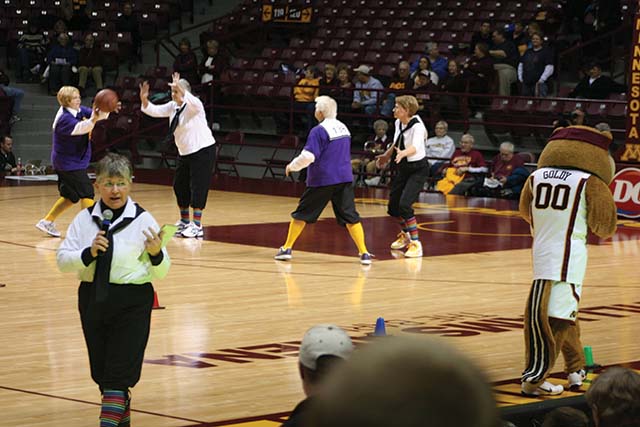
Sterling, who coached girls’ basketball at high schools in Morristown, Faribault and at Shattuck-St. Mary’s, said playing Granny Basketball “brings back a lot of memories” from her playing days in Iowa. She has also found it a “good way to socialize,” with rules which allow anyone to play. Sterling had All-State honors in Iowa and, while in junior college in Estherville, she attended a tryout for the All-American Red Heads (the longest running women’s professional sports team, from 1936 to 1986). She was also offered a tryout for the Royal Blues team from St. Louis. She decided not to go pro because she wasn’t comfortable about playing a full-court game against men. (These matches were fundraisers, such as the Globetrotters do. Granny Basketball now asks for free will admissions at their games, with proceeds to charities.)
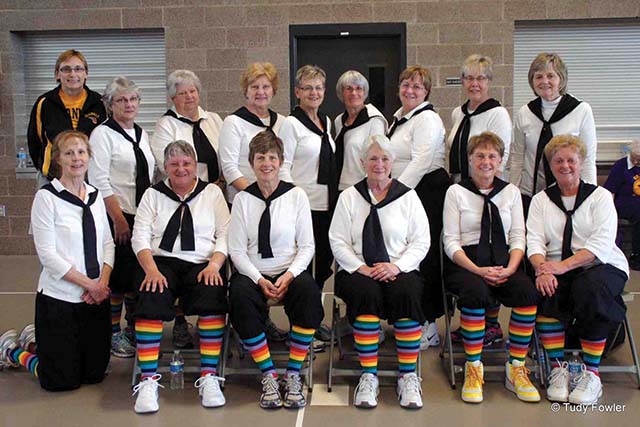

The Faribault Hot Shots can boast of a true “hot shot” in tall and athletic Elsie Slinger. While on the sidelines at the scrimmage, I heard someone comment, “She has such long arms, when Elsie’s guarding, you may as well forget it.” Slinger was Elsie Ohm when she played three varsity seasons at John Marshall in Rochester, graduating in 1976. In her senior year, her team lost 43-41 to Faribault in the regional final, falling just short of being part of the first girls state tournament of the Minnesota State High School League. She went on to play for the Minnesota Golden Gophers for three years (leading the 1977-78 Gophers scorers with a 16.5 point average per game), then finished her collegiate play at Mankato State, winning All-American honors. In March of 1981, she stepped in to play four games for the Minnesota Fillies of the short-lived professional Women’s Basketball League when players walked out after not being paid. (She told me that she was a center in high school, forward in college and a guard with the Fillies.)
Slinger, who has lived in Faribault more than 30 years, said it has been a “real treat” to “meet people you never would have crossed paths with” through playing Granny Basketball. Playing the game also brought her back to Williams Arena, home of the Gophers, on Jan. 12, 2012. The Bulldogs and the Hot Shots gave a short exhibition of their game during halftime of a University of Minnesota women’s basketball game. Slinger told me it was her first time back, so it “brought back a lot of great memories.” And when the game started, “I felt like running down the end after making a basket!” – which, of course, would have broken a cardinal Granny Basketball rule.

On Jan. 31 of this year, several Grannies from the Wanamingo Bulldogs team went to Cedar Rapids, Iowa, for a Jamboree of 14 teams. After the morning competitions of 16 minutes per game (in which the Gowrie Firecrackers beat the Bulldogs 22-9), the ladies played on six new teams, grouped according to age, ranging from two “Glorious Oldest Grannies” teams to two “Feisty Youngest Grannies.” During the break between activities, the Wanamingo participants sang a song for the occasion to the tune Oleana for which they had written the words, “Life in Wanamingo is sweet/ And all the work just floats away./ The cows all like to milk themselves,/ And the hens lay eggs ten times a day.” (This team is also known for its cheer, “Lutefisk. Lutefisk. Lefse. Lefse. We’re the mighty Bulldogs. Ya, sure, you betcha.”)
The two Minnesota teams have an official matchup in Wanamingo in March, then the two Minnesota teams will be playing the Cedar Rapids Sizzlers and Center Point Model Ts from Iowa in Wanamingo on April 25, starting at 10 a.m. in the Kenyon-Wanamingo Elementary School gym in Wanamingo. Spectators are welcome.
Before the Bulldogs and Hot Shots left the January scrimmage, Slinger (who said she was “probably the youngest one here”) paid tribute to her mentors, the women who coached the game but did not get to play basketball themselves in school as she did. “I know how I would feel if I never got to play,” Slinger said. “I can see how much they love the game.”
Founder McPherson told me each team plays seven games in the season which runs from January through May. A state tournament will be held in Des Moines June 5-6, with a national tournament at a place still to be determined in July. The two Minnesota Granny Basketball teams would love to spread the word to other communities to encourage further participation and the formation of other teams. There is also a need for referees, coaches and scorekeepers. The website for the program is grannybasketball.com.

Girls’ Six-on-Six Basketball
When I was doing graduate work at Iowa State University in the 1970s, I watched in bemusement as the state of Iowa went cuckoo over state girls’ basketball tournaments.
In my high school in Brookings, S.D., the girls had no interscholastic competition, just a Girls Athletic Association All-Star Game at an assembly where boys poked fun at the girls playing the six-on-six, stay-in-your-half-of-the-court basketball game. Two dribbles, only forwards could score. I remember hitting two baskets one year, taking high scoring honors with those four points. (Don’t laugh. Carleton College men only mustered eight points when St. Olaf won the first basketball game between these cross-town rivals, held at Carleton’s newly constructed Sayles-Hill Gymnasium in 1910! Final score 22-8.)
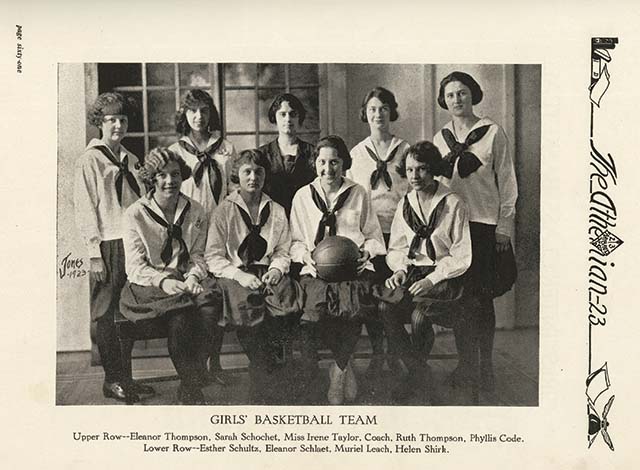
Yet, here in Iowa, there had been a girls’ state tournament since 1920. The game (played mostly in rural areas) gained growing national attention, from major networks to ESPN to Sports Illustrated to big city press. The tournaments for girls outdrew those for boys.
The Faribault Hot Shots of Granny Basketball honor the legacy of teams that played in the 1920s, including this Faribault High School team shown in the 1923 Athenian. Note: Eleanor Schlaet is the mother of Marian Bemis Johnson who, with Dorothy E. McIntyre, published Daughters of the Game in 2005 about the first era of girls high school basketball in Minnesota. Courtesy of the Rice County Historical Society.
Folks were still talking about the “Dream Game” held before 15,000 fans at Veterans Memorial Auditorium in Des Moines on March 16, 1968, for the Iowa Girls High School State Basketball title. The game featured the top two scorers in the state: Union-Whitten’s Denise Long, averaging 69.6 points per game, and Everly’s Jeannette Olson, averaging 59.5 points per game. Union-Whitten prevailed 113-107 in overtime, with Long scoring 64 points and Olson 76. (It must be noted that these were not always high scoring games. In 1979, a low-scoring stalling game in days when there was no shot clock took place in the district final between Melvin and Sibley. The regulation game ended 0-0, with Melvin winning 4-2 in the fourth overtime.)
Six-on-six girls’ games were played in Iowa through 1984, when (to settle a suit) the state agreed schools could choose whether to play with six or five players. Finally, the six-player era ended in Iowa in 1993. So, it is no wonder that the Granny Basketball League still sounds a nostalgic note for many Iowans. It has been estimated that at one time 70 percent of all high school girls played basketball in Iowa.
That was far from the case in Minnesota, even though Carleton College women had been the first Minnesota collegians to play the new game of “basket ball” during the 1892-1893 school year, thanks to Max J. Exner. James Naismith, Exner’s roommate at the YMCA Training School in Springfield, Mass., had invented the game to provide indoor exercise for male students, with Exner playing in the very first game Dec. 21, 1891. When Exner was hired as “physical culture” instructor at Carleton, he introduced the game to the women. The Algol yearbook said, “You should have seen the fun” and described the girls with their eyes “sparkling with excitement, ready to dash at the ball when put into play.” The conclusion: “Are girls fit for the drawing room only? Can they participate in active games as boys can? Were you permitted to witness one of these games you would surely conclude that they can.”
The game spread quickly. Northfield girls were attracted to the game and played their first game against another high school on Nov. 4, 1904, losing a home contest to St. James School 39-6. In years that followed, thousands of girls in Minnesota represented their schools and communities, traveling by train, sleighs, bobsleds, cars and buses to games in gyms, armories, dance halls or city halls, wherever a basket could be hung. By the 1920s, there were girls’ teams in most of the Minnesota high schools, but no statewide rules. Gradually the three-court game (now played in Granny Basketball) was replaced by two-court, six-on-six ball. The boys (who could withstand the “rigors” of five-on-five, full-court basketball) had a state tournament starting in 1913, first held at Carleton’s new Sayles-Hill Gym. With no girls’ state tournament, Owatonna girls sent out a challenge in 1919 which only one team accepted, and when Owatonna defeated New Ulm 24-18, Owatonna girls declared themselves “state champs.” (The first Minnesota girls state tournament was not held until 1976, using the five-player, full-court game which had been adopted in 1971.)
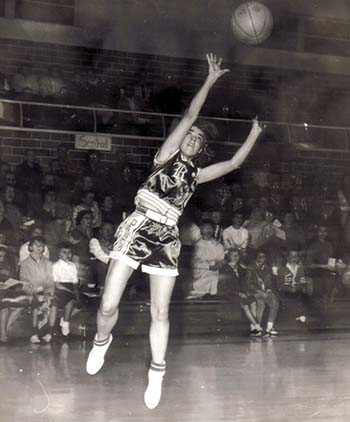
The 2005 book, Daughters of the Game: The First Era of Minnesota Girls High School Basketball 1891-1942 by Marian Bemis Johnson and Dorothy E. McIntyre, explains why the interscholastic girls’ teams disappeared in Minnesota by 1942, not to be revived for decades. (In 2012, Johnson and McIntyre published a fictionalized account of this era called Two Rings: A Legacy of Hope.) In 1924, the National Amateur Athletic Federation-Women’s Division was organized and began to recommend that all competitive sports for girls should be replaced with Girls Athletic Association (GAA) programs which would be accessible to more girls and avoid the alleged negative effect on their health. Consider this statement from Agnes Wayman, President of the American Physical Education Association, in 1933: “External stimuli such as cheering audiences, bands, lights, etc., cause a great response in girls and are apt to upset the endocrine balance. Under emotional stress, a girl may easily overdo. There is a widespread agreement that a girl should not be exposed to extremes of fatigue or strain, either emotional or physical.”
Harold Jack, Supervisor of Physical Education in Minnesota, wrote in a letter to Minnesota schools that the drop in girls interscholastic competition from 92 schools in 1938-39 to 38 schools in 1939-40 “represents a decided change for the better.” The result: many girls were deprived of the opportunity to play the game they loved against other schools. By contrast, a school superintendent at Mystic, Iowa, spoke out at a meeting in Des Moines: “Gentlemen, if you attempt to do away with girls basketball in Iowa, you’ll be standing in the center of the track when the train runs over you!”
Rural schools in Minnesota held onto their teams longer than larger schools but by 1942, the first era of girls’ basketball was over. Minnesota finally adopted competitive girls’ sports in 1969, just ahead of Title IX in 1972 which barred sex discrimination in educational institutions that received federal funds.
And now, of course, “March madness” includes teams of both sexes playing the five-player game throughout the country. But “six-on-six” lives on in distant memories and, since 2005, in Granny Basketball.


